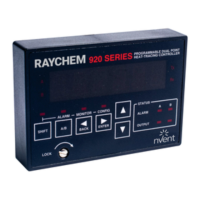57 / 82
EN- Raychem920series-IM-H5687405/15
INDUSTRIAL HEAT TRACING SOLUTIONS
6.3 COMMON ALARMSWHAT TO LOOK FORCONTINUED
Alarm Description Cause of Alarm
High Voltage Alarms voltage levels that are greater than
the HIGH VOLTAGE ALARM setting
• Alarm setting too close to normal operating voltage
• Incorrect wiring
• Incorrect VOLTAGE TURNS RATIO
• Power surge
Low Voltage This alarms voltage levels which are less
than the LOW VOLTAGE ALARM setting.
• Alarm setting too close to normal operating voltage
• Damaged power cable
• Incorrect VOLTAGE TURNS RATIO
• Brown-out conditions
• Loss of power to the circuit
Overcurrent Trip If the controller is unable to start the cable
due to high current or after attempting to
soft start it, the controller trips off its output
switch.
• Excessive in-rush current
• Incorrect wiring
• Damaged cable
• Switch rating set too low
• Incorrect CURRENT TURNS RATIO setting
Switch Failure This alarm will indicate that the controller
senses current flow when the output switch
should be off.
• Some other device has energized the heat trace cable
• Output switch has failed
HTC Reset This alarm is latched when power is restored
after an interruption. Used to identify
intermittent power losses.
• Circuit breaker tripped
• Power line transient
Power Limiting This alarm indicates that the solid-state
relay is limiting the average amount of power
that is applied to the trace circuit as defined
by the MAXIMUM POWER setting.
• Power applied to trace circuit is being limited to the
MAXIMUM POWER setting
• Incorrect VOLTAGE and/or CURRENT TURNS RATIO
setting
C B Limiting This alarm indicates that the controller is
limiting the average current to the CIRCUIT
BREAKER CURRENT RATING setting.
• Excessive current caused by in-rush current
• C.B. CURRENT RATING setting too low for normal
heater current draw or not matched to actual circuit
breaker size
• Incorrect CURRENT TURNS RATIO setting
Switch Limiting This alarm indicates that the controller is
limiting the average current that is applied
to the trace circuit based on the SWITCH
RATING setting to protect the solid-state
relay from excess current.
• Excessive current caused by in-rush current
• Incorrect CURRENT TURNS RATIO setting
High Resistance This alarm indicates that the heating cable
resistance has deviated from the NOMINAL
RESISTANCE setting by more than the HIGH
RESISTANCE ALARM setting.
• Alarm setting too close to actual operating resistance
• NOMINAL RESISTANCE not set properly
• Open connection—wiring problem
• Damaged cable
• Incorrect VOLTAGE and/or CURRENT TURNS RATIO
setting
Low Resistance This alarm indicates that the heating cable
resistance has deviated from the NOMINAL
RESISTANCE setting by more than the LOW
RESISTANCE ALARM setting.
• Alarm setting too close to actual operating resistance
• NOMINAL RESISTANCE not set properly
• Partial short—wiring problem
• Damaged cable
• Incorrect VOLTAGE and/or CURRENT TURNS RATIO
setting

